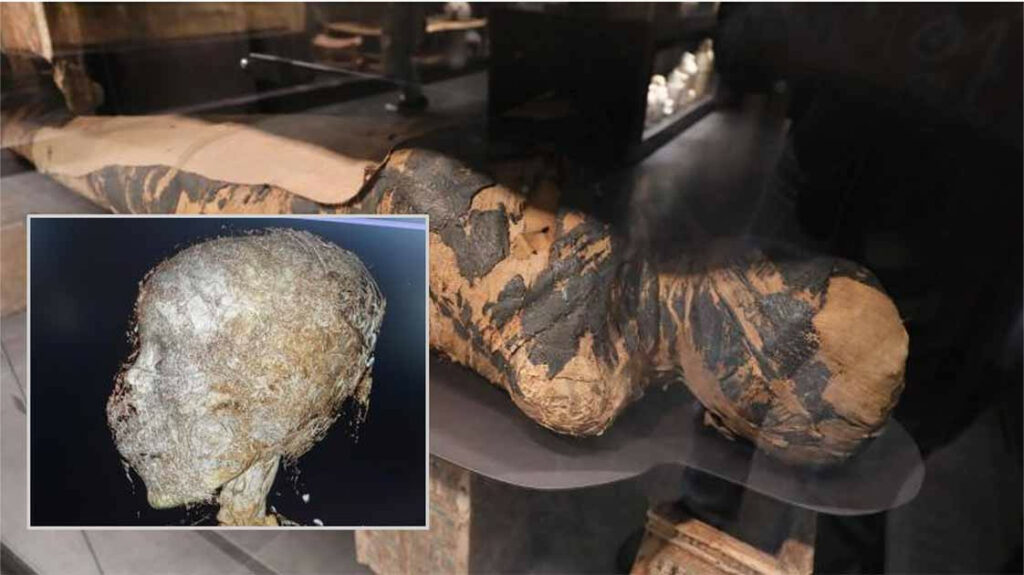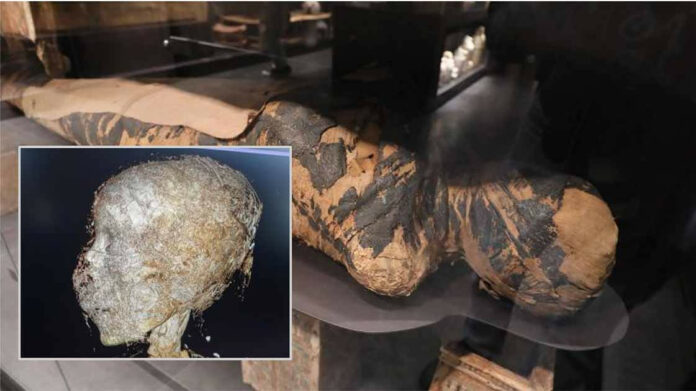2,000-Year-Old Mummy Studied by Polish Researchers
A multidisciplinary team of researchers from the University of Warsaw has examined the remains of a 2,000-year-old Egyptian mummy, which is currently housed at the National Museum in Warsaw, Poland. The mummy, brought to Poland in the 19th century, has been in the possession of the University of Warsaw since 1917 and is displayed in the ancient art gallery of the national museum.

Mummy’s Skeleton Reveals Potential Tumor Changes
The study, conducted by the Warsaw Mummy Project in collaboration with the Department of Oncology at the Medical University of Warsaw, suggests the presence of tumor changes in the bones. The facial changes observed in the nasopharyngeal bones are not typical of the mummification process, indicating the possibility of nasopharyngeal carcinoma (NPC), the most common cancer originating in the postero-lateral nasopharynx or pharyngeal recess (fossa of Rosenmüller).
Prof. Rafał Stec from the Department of Oncology estimates a high probability that the young woman died from cancer, given the lack of other potential causes of death discovered during the examination. He states, “First, we have unusual changes in the nasopharyngeal bones, which is not typically found in mummified carcasses, and the only certain diagnosis is possible after a histopathological examination. Second, radiologists’ opinions based on computed tomography indicate the probability of tumor changes in the bones.”
Carcinoma in Ancient Egypt and Future Research
Carcinoma was prevalent in ancient Egypt, with several known cases of nasopharyngeal cancer. The researchers plan to collect tissue samples from the mummy for comparison with samples from other Egyptian mummies preserved in the United States and the United Kingdom.
The study aims to determine if the cancer was caused by a viral infection, such as HPV, or by a genetic predisposition. The findings will contribute to the understanding of cancer evolution and the development of new diagnostic and treatment methods. The research was published in Science in Poland, highlighting the potential for ancient mummified remains to advance modern medicine.
Uncovering the Secrets of Ancient Egyptian Health

The discovery of cancer cells in the 2,000-year-old Egyptian mummy has significant implications for modern medicine. By studying the preserved remains of ancient individuals, researchers can gain valuable insights into the evolution of diseases and the factors that contributed to their development.
Collaborative Efforts in Mummy Research
The Warsaw Mummy Project, in collaboration with various institutions and experts, demonstrates the importance of interdisciplinary research in unraveling the mysteries of ancient civilizations. By combining the expertise of archaeologists, anthropologists, oncologists, and radiologists, a more comprehensive understanding of the mummy’s health can be achieved.
Implications for Modern Medicine
The identification of nasopharyngeal carcinoma in the ancient Egyptian mummy can contribute to the development of new diagnostic tools and treatment strategies for this type of cancer. By comparing the genetic and molecular characteristics of the ancient cancer cells with those of modern patients, researchers may uncover previously unknown risk factors or therapeutic targets.

Furthermore, the study of ancient diseases can shed light on the evolution of human health and the impact of environmental and lifestyle factors on disease development. This knowledge can inform public health policies and preventive measures to address the growing burden of chronic diseases in modern societies.
Preserving and Studying Ancient Remains
The preservation and study of ancient mummies and skeletal remains are crucial for advancing our understanding of human history and health. Museums and research institutions play a vital role in safeguarding these invaluable resources and facilitating their scientific investigation.
As more advanced technologies become available, such as high-resolution imaging and genetic sequencing, researchers will be able to extract even more information from ancient remains. This will not only deepen our knowledge of past civilizations but also contribute to the development of personalized medicine and targeted therapies for modern patients.
The discovery of cancer in the 2,000-year-old Egyptian mummy highlights the enduring relevance of ancient remains in modern medical research. By unraveling the secrets of our ancestors’ health, we can better understand and address the challenges of human health in the present and future.

